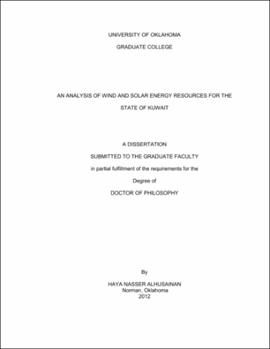| dc.contributor.advisor | Greene, Scott | |
| dc.creator | Alhusainan, Haya Nasser | |
| dc.date.accessioned | 2019-04-27T21:40:10Z | |
| dc.date.available | 2019-04-27T21:40:10Z | |
| dc.date.issued | 2012 | |
| dc.identifier | 9977739402042 | |
| dc.identifier.uri | https://hdl.handle.net/11244/319313 | |
| dc.description.abstract | Kuwait is an important producer of oil and gas. Its rapid socio-economic growth has been characterized by increasing population, high rates of urbanization, and substantial industrialization, which is transforming it into a large big energy consumer as well. In addition to urbanization, climatic conditions have played an important function in increasing demand for electricity in Kuwait. Electricity for thermal cooling has become essential in the hot desert climate, and its use has developed rapidly along with the economic development, urbanization, and population growth. This study examines the long-term wind and solar resources over the Kuwait to determine the feasibility of these resources as potential sustainable and renewable energy sources. | |
| dc.description.abstract | The ultimate goal of this research is to help identify the potential role of renewable energy in Kuwait. This study will examine the drivers and requirements for the deployment of these energy sources and their possible integration into the electricity generation sector to illustrate how renewable energy can be a suitable resource for power production in Kuwait and to illustrate how they can also be used to provide electricity for the country. For this study, data from sixteen established stations monitored by the meteorological department were analyzed. A solar resource map was developed that identifies the most suitable locations for solar farm development. A range of different relevant variables, including, for example, electric networks, population zones, fuel networks, elevation, water wells, streets, and weather stations, were combined in a geospatial analysis to predict suitable locations for solar farm development and placement. An analysis of recommendations, future energy targets and strategies for renewable energy policy in Kuwait are then conducted. | |
| dc.description.abstract | This study was put together to identify issues and opportunities related to renewable energy in the region, since renewable energy technologies are still limited in Kuwait because, compared to the cost of conventional electricity in Kuwait, the cost of renewable energy-based electricity is very high. However, the abundant availability of the solar and wind energy as clean renewable energy in Kuwait offers the country significant opportunities to become a leader in the renewable energy sector. In a competition with subsidized oil and gas energy, the success of renewable energy technologies in Kuwait will be subject to the ability of the state to introduce supporting policies, including financial incentives and a regulatory framework to encourage deployment and reduce cost. | |
| dc.format.extent | 175 pages | |
| dc.format.medium | application.pdf | |
| dc.language | en_US | |
| dc.relation.requires | Adobe Acrobat Reader | |
| dc.subject | Solar energy--Kuwait | |
| dc.subject | Wind power--Kuwait | |
| dc.subject | Renewable energy sources--Kuwait | |
| dc.title | AN ANALYSIS OF WIND AND SOLAR ENERGY RESOURCES FOR THE STATE OF KUWAIT | |
| dc.type | text | |
| dc.type | document | |
| dc.thesis.degree | Ph.D. | |
| ou.group | College of Atmospheric & Geographic Sciences::Department of Geography and Environmental Sustainability | |
